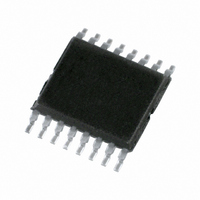SC16IS740IPW,112 NXP Semiconductors, SC16IS740IPW,112 Datasheet - Page 57

SC16IS740IPW,112
Manufacturer Part Number
SC16IS740IPW,112
Description
IC UART SINGLE W/FIFO 16-TSSOP
Manufacturer
NXP Semiconductors
Type
UART with 64-byte FIFOs and IrDA encoder/decoderr
Datasheet
1.SC16IS740IPW112.pdf
(62 pages)
Specifications of SC16IS740IPW,112
Number Of Channels
1, UART
Package / Case
16-TSSOP (0.173", 4.40mm Width)
Fifo's
64 Byte
Protocol
RS232, RS485
Voltage - Supply
2.5V, 3.3V, 5V
With Auto Flow Control
Yes
With False Start Bit Detection
Yes
With Modem Control
Yes
Mounting Type
Surface Mount
Data Rate
5 Mbps
Supply Voltage (max)
3.6 V
Supply Voltage (min)
2.3 V
Supply Current
6 mA
Maximum Operating Temperature
+ 85 C
Minimum Operating Temperature
- 40 C
Mounting Style
SMD/SMT
Operating Supply Voltage
2.5 V, 3.3 V
Lead Free Status / RoHS Status
Lead free / RoHS Compliant
For Use With
568-4000 - DEMO BOARD SPI/I2C TO DUAL UART568-3510 - DEMO BOARD SPI/I2C TO UART
Lead Free Status / Rohs Status
Lead free / RoHS Compliant
Other names
568-3648-5
935280988112
SC16IS740IPW
935280988112
SC16IS740IPW
Available stocks
Company
Part Number
Manufacturer
Quantity
Price
Company:
Part Number:
SC16IS740IPW,112
Manufacturer:
JAMICON
Quantity:
101
NXP Semiconductors
16. Handling information
17. Soldering of SMD packages
SC16IS740_750_760_6
Product data sheet
17.1 Introduction to soldering
17.2 Wave and reflow soldering
17.3 Wave soldering
Inputs and outputs are protected against electrostatic discharge in normal handling.
However, to be completely safe you must take normal precautions appropriate to handling
integrated circuits.
This text provides a very brief insight into a complex technology. A more in-depth account
of soldering ICs can be found in Application Note AN10365 “Surface mount reflow
soldering description” .
Soldering is one of the most common methods through which packages are attached to
Printed Circuit Boards (PCBs), to form electrical circuits. The soldered joint provides both
the mechanical and the electrical connection. There is no single soldering method that is
ideal for all IC packages. Wave soldering is often preferred when through-hole and
Surface Mount Devices (SMDs) are mixed on one printed wiring board; however, it is not
suitable for fine pitch SMDs. Reflow soldering is ideal for the small pitches and high
densities that come with increased miniaturization.
Wave soldering is a joining technology in which the joints are made by solder coming from
a standing wave of liquid solder. The wave soldering process is suitable for the following:
Not all SMDs can be wave soldered. Packages with solder balls, and some leadless
packages which have solder lands underneath the body, cannot be wave soldered. Also,
leaded SMDs with leads having a pitch smaller than ~0.6 mm cannot be wave soldered,
due to an increased probability of bridging.
The reflow soldering process involves applying solder paste to a board, followed by
component placement and exposure to a temperature profile. Leaded packages,
packages with solder balls, and leadless packages are all reflow solderable.
Key characteristics in both wave and reflow soldering are:
Key characteristics in wave soldering are:
•
•
•
•
•
•
•
•
Through-hole components
Leaded or leadless SMDs, which are glued to the surface of the printed circuit board
Board specifications, including the board finish, solder masks and vias
Package footprints, including solder thieves and orientation
The moisture sensitivity level of the packages
Package placement
Inspection and repair
Lead-free soldering versus SnPb soldering
Single UART with I
Rev. 06 — 13 May 2008
2
C-bus/SPI interface, 64-byte FIFOs, IrDA SIR
SC16IS740/750/760
© NXP B.V. 2008. All rights reserved.
57 of 62
















